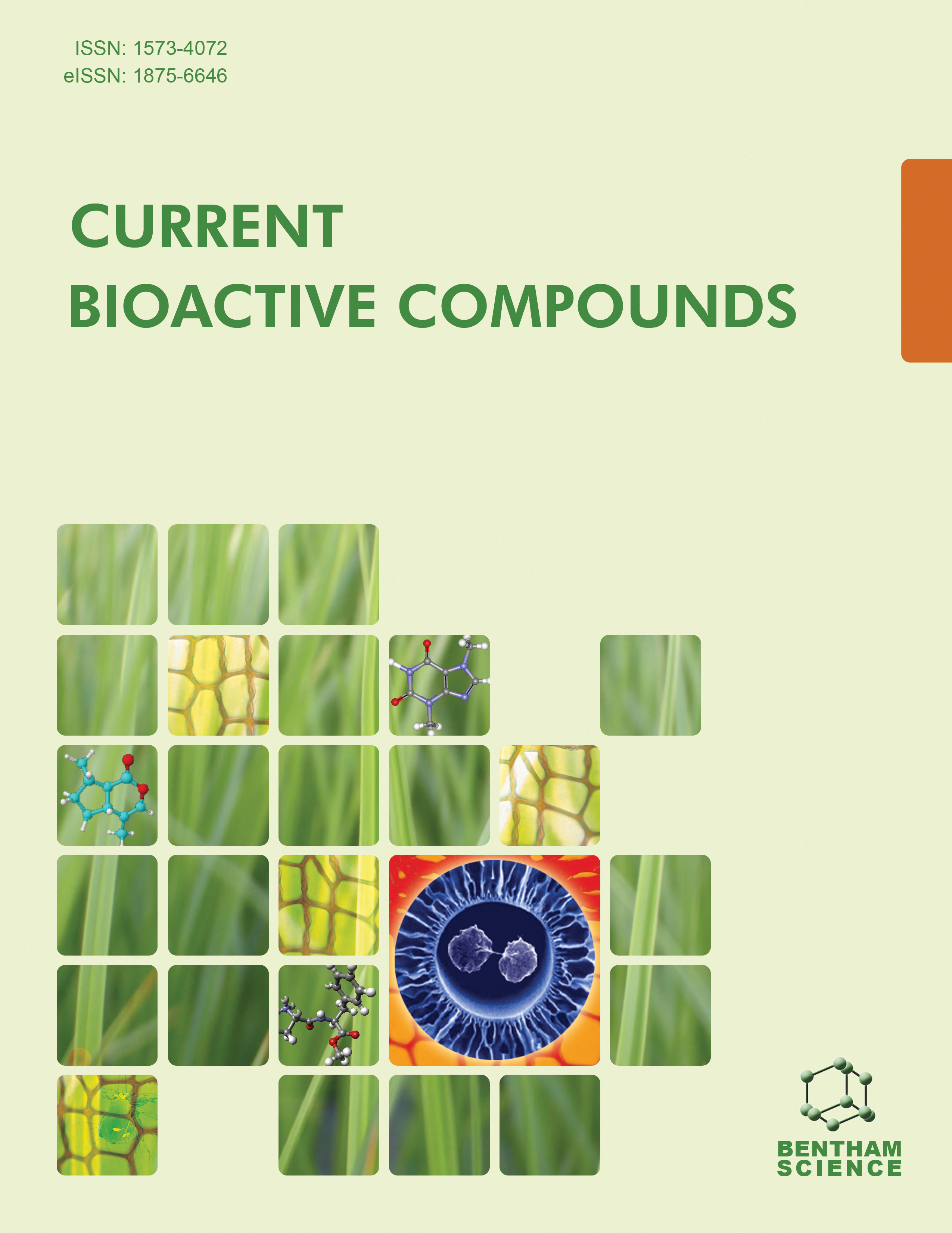- Home
- A-Z Publications
- Current Bioactive Compounds
- Previous Issues
- Volume 5, Issue 3, 2009
Current Bioactive Compounds - Volume 5, Issue 3, 2009
Volume 5, Issue 3, 2009
-
-
Editorial [Hot Topic: Nanostructure for Therapeutics Applications (Guest Editor: Cato T. Laurencin and Lakshmi S. Nair)]
More LessAuthors: Cato T. Laurencin and Lakshmi S. NairIt is our honor and privilege to serve as the Guest Editors of the Special Edition on “Nanostructures for Therapeutic Applications” for the journal “Current Bioactive Compounds”. The past decade has witnessed an unprecedented growth in the area of nanotechnology. This in turn has provided valuable tools to understand the biological systems and processes at a much closer level than was previously possible. The combination Read More
-
-
-
Recent Developments in Nanoparticle Based Targeted Delivery of Chemotherapeutics
More LessAuthors: M. S. Peach, Sangamesh G. Kumbar, Justin L. Brown and Cato T. LaurencinCancer is currently responsible for approximately one quarter of all deaths each year in the United States [1]. Decades of refinement to cancer treatment has led to a multimodal approach, which combines surgery with radiation and/or chemotherapy. However, aggressive and advanced stages of cancer are only slightly hindered with drugs and radiation at the cost of considerable patient morbidity. Implementation of nan Read More
-
-
-
Nanostructures for Treating Musculoskeletal Conditions
More LessAuthors: Joseph W. Freeman and M. N. RylanderThe use of nanoscale structures and features is becoming increasingly popular in tissue engineering, and for good reason. Devices that have features in the nano-length scale offer many benefits that their counterparts do not. These features can alter cellular behavior including cell attachment, degree of cell spreading, and cellular alignment. These properties affect the arrangement of extracellular matrix material p Read More
-
-
-
Nanostructures for Bypassing Blood Brain Barrier
More LessAuthors: Junping Wang, Chandra M. Valmikinathan and Xiaojun YuThe Blood Brain Barrier (BBB) represents a fundamental challenge towards development of therapy for disease in the brain such as brain tumor, Parkinson's disease and Alzheimer's disease. The passage across the BBB is vital to the success of a therapeutic platform and nanotechnology based systems provide great potential for solving the problem. This chapter discusses the structures and functions of the BBB, the trans Read More
-
-
-
Nanomedicine: Addressing Cardiovascular Disease and Cardiovascular Tissue Regeneration
More LessAuthors: Rebekah A. Neal, Olugbemisola Oredein-McCoy and Edward A. BotchweyCardiovascular disease is becoming an increasingly significant problem. In attempts to overcome many of the traditional hurdles of cardiovascular disease treatment, therapeutic approaches have been gradually moving beyond an exclusive focus on orally delivered drugs towards the development of nanoscale applications. These technologies exploit molecular scale events to improve drug and gene delivery applicatio Read More
-
-
-
Pomolic Acid Isolated from the Leaves of Licania pittieri Inhibits ADP-and Epinephrine-Induced Platelet Aggregation and has Hypotensive Effect on Rats
More LessAuthors: O. Estrada, C. Alvarado-Castillo, A. Z. Fernandez, M. Lopez, E. Romero-Vecchione, J. Vasquez, J. Mendez, D. Conde and A. CardozoSeveral Chrysobalanaceae family members are considered medicinal plants in South America and their infusions have been widely used to treat several diseases, such as diabetes and hypertension. Methanolic extract from the leaves of Licania pittieri (Chrysobalanaceae), has previously shown hypotensive effect in anaesthetized normotensive rats. The aim of this study was to identify the compounds present in the metha Read More
-
-
-
Recent Advances of Metal Binding Protein Lactoferrin as an Anti- Microbial Agent
More LessAuthors: Isha Gupta, Rakesh Sehgal, Rupinder K. Kanwar, Alka Sehgal and Jagat R. KanwarLactoferrin (Lf) is present in milk and gland secretions and serve as an antimicrobial function. Insufficient amounts of Lf in some secretions also appear to correlate with certain health problems. Protection against gastroenteritis is the most likely biologically relevant activity of lactoferrin. Multiple in vitro and animal studies have shown a protective effect of lactoferrin on infections with enteric microorganisms, including rot Read More
-
-
-
Research Advances on Anticancer Effect of Licorice
More LessAuthors: Tianshui Niu, Jianshe Yang, Long Zhang, Xiao Cheng, Kai Li and Gang ZhouLicorice as a kind of traditional Chinese medicine is widely used for more than one thousand years. Modern studies show that Licorice has antibacterial, antiviral, antioxidant, and other pharmacological effects. In recent years, the anti-tumor effect of Licorice has evoked the great interest due to its bioactive ingredients. The most active ingredients in Licorice mainly include triterpenes, flavonoids, polysaccharides, a Read More
-
Volumes & issues
-
Volume 21 (2025)
-
Volume 20 (2024)
-
Volume 19 (2023)
-
Volume 18 (2022)
-
Volume 17 (2021)
-
Volume 16 (2020)
-
Volume 15 (2019)
-
Volume 14 (2018)
-
Volume 13 (2017)
-
Volume 12 (2016)
-
Volume 11 (2015)
-
Volume 10 (2014)
-
Volume 9 (2013)
-
Volume 8 (2012)
-
Volume 7 (2011)
-
Volume 6 (2010)
-
Volume 5 (2009)
-
Volume 4 (2008)
-
Volume 3 (2007)
-
Volume 2 (2006)
-
Volume 1 (2005)
Most Read This Month
Article
content/journals/cbc
Journal
10
5
false
en

Most Cited Most Cited RSS feed
-
-
Podophyllotoxin: Current Perspectives
Authors: Ying Qian Liu, Liu Yang and Xuan Tian
-
- More Less

